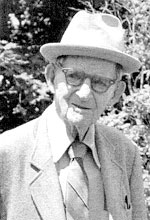
WASHINGTON COUNTY HISTORICAL SOCIETY (Washington County, Utah)
"NELS ANDERSON"
by Kelton Hafen
November 2011
This was at a time in the history of America when work was scarce and times were tough. Many men would catch rides on a freight train to try to find work. The railroad hired men to try to keep these hobo's off of the train. Those employed were called railroad "bulls". At Acoma the bulls removed Nels from the train. He had heard they were building the Panama Canal and was on his way to the coast trying to get there.
The Woods family took Nels in, and they could see his potential so they took him in and he stayed with them and attended school at the Barclay School House. (The early pioneers called the area Clover Valley but there was another Clover Valley in Northern Nevada, so after 1905 the name Barclay used by the railroad was adopted).
Nels was an exceptional student. After completing the 8th grade at Barclay he went to the BYU Academy and University in Provo, Utah. There he lived with the James Bird Woods family. He then attended Dixie College in St. George, Utah and lived with Thomas and Roxa Woods Terry. He then went to North Western University and received his PhD Degree and became a world renowned Sociologist. He is still recognized as the worlds leading authority on the "hobo" era in America.
In my personal opinion Nels found a home with the Woods and Terry families and he developed a great love and respect for them. He joined the LDS Church but was never completely converted. He was an intellectual man and looked at things from an academic viewpoint and not so much of the spiritual side. He wrote a book called Desert Saints which is a very good history of the Enterprise and St. George, Utah area. It was written by one who was sympathetic to the Church but does not focus on the spiritual dedication behind the settling of South Western Utah.
The Utah Historical Society has enough interest in Nels Anderson that they are in the process of writing a book about his life. Chas Peterson and Kent Powell are doing the research for this book. They have found much of his history which includes the fact that his father was from the Old Country and spoke with a European accent. One day Nels' father saw a young lady on a park bench crying. He found out she was pregnant and that her parents had disowned her. After a short courtship they were married and Nels was the second child and had at least one sister. Nels' father was a very stern man. He wanted his family to stay close. He bought a farm where the family could all work closely together. Nels always wondered why is older brother had a darker skin color than the rest of the family. He didn't know this part of his history until he was older. Timeswere hard during the early 1900's. So Nels and his older brother took to "hoboing" trying to find work.
The popular view of "hobo's" or "bums" as they were called is that they just traveled by train from place to place looking for a handout. Nels saw them as mostly good men looking for work so they could sustain themselves and send money home to their families.
Nels was in the Army during World War One. He kept a very good diary that will be a major part of his history in the stories that are being written. He was married but they had many problems and it ended in divorce. After the War he was primarily involved in education spending the majority of his time in Europe, possibly to distance himself from his marital troubles.
While at Dixie he was involved with the debate team. Some of his closet associates at Dixie were Elis Picket and Leroy Cox. Both were quite intellectual and not too involved in the LDS Church. Both became prominent attorneys in St. George.
In a copy of the 1913 Dixie College yearbook which he had sent to his sister, he wrote several notes. One note next to the photo of A.K. Hafen who was teaching at Dixie at that time said that "he" A.K. Hafen "married my girlfriend". My mother Orilla would have been two years older than Nels. He apparently had taken a liking to her. According to Chas Peterson, Nels was interested in several Mormon girls but did not marry any of them.
Because both Nels and Juanita Brooks were historians they kept in touch over the years. In 1976 we were having my mother's 85th birthday party at Dixie College. Nels flew into St. George and Juanita's son Karl Brooks picked him up at the airport and brought him to the party. All of Orilla's family was able to meet Nels. This is just one example of the goodness and hospitality of the Woods and Terry families.
Note: Another example of the Woods/Terry hospitality is that of Jake Busher. He was hobo kicked off the train at Crestline, Nevada. He walked the 20 miles to Terry's ranch where he was taken care of by Tom and Roxa Woods Terry. Jake Busher was from the old Country and spoke with a foreign dialect. He married an Enterprise, Utah girl and they had a grocery store and he did trucking between Los Angeles and Enterprise. They raised a family in Enterprise.